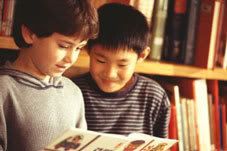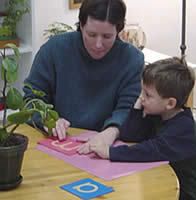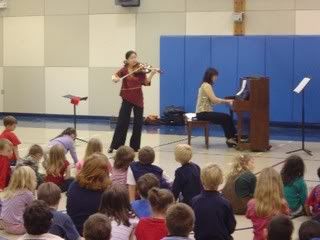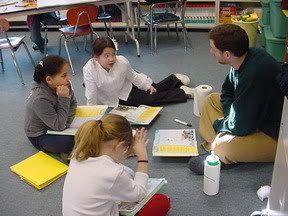Let me mention the subject of Home Schooling. What thought immediately comes to mind? There have always been many views of home schooling. There are varieties of opinions ranging from great parents to troublemakers. Most of the negative thoughts of home schooling are based on rumors and preconceived ideas. Out of all thoughts about home schooling, socialization is one of the first things that come to mind. The most debated topic among home schoolers and non-home schoolers is this issue of adequate socialization for home schooled children. Some think that home schoolers do not get enough socialization. They feel since the children are home for school this makes the child become socially deprived. Home schooled children are not socially deprived.
As a home schooling parent, and from my personal experience my children are more social at times than I am. Many studies support the home school academic benefit, but what about social aspect? Are home schoolers missing proper socialization? Is there a right solution for the socialization problem? Is there a socialization problem at all? With the growth of home schoolers seen recently are we bound to have future generations of socially deprived misfits?
What is home schooling anyway? Why is the choice a debated topic? Is it just a passing trend? Home schooling is home education. This educational decision is a parents' choice and right to teach his or her children one on one at home. This option is legal in all fifty states. Home schooling options have grown greatly due to many accredited curriculum providers targeting the large growing market of home schooling. These curriculum companies are providing parents with easy, different and even customized options for home schooling.
Home schooling just trend right? No. In 1999, the National Center for Education Statistics reported an estimated 850,000 students nationwide were being home schooled (10). The numbers are estimated to grow due to the popularity and the knowledge of home school benefits being explored. More parents are taking the home school route for the safety and academic achievements of their children. Home education is nothing new; it has been around for years. According to Home4schoolgear.com the famous Artist Leonardo Di Vinci, and Inventors Alexander Graham Bell, Thomas Edison and few presidents of prestigious colleges were home educated along with many other famous trailblazers (Home4schoolgear.com). Only in recent years has home education been media news. Home schooling as shown its solid foundation in successful results through time. Still there are those that have debated the choice of home education.
Home education has grown so much that most cities have home school groups for support, courses, activities and much more. There is also Home School Legal Defense Association to support families with home school legal issues. There are home schooling magazines, clothing and more. Will the growth of home schooling have an effect on public schools? Some feel that home schooling directly effects the public schools. There have been arguments that home schooling can have an effect on public schools in positive or a negative ways.
Paul T. Hill, author of “How Home Schooling Will Change Public Education” says, “Home schooling limits public school enrollments, therefore it reduces the money provided to school districts. Home schooling also reduces growth in public schools, and decreases the pressure for new buildings and staffs”(Hill). The concern of money for public schools has been a raising issue for years. Home schooling does not have a major effect on it. The problem of public school money issues is caused by a number of factors other than home schooling. There have been various news reports of public school officials misusing the money, and the debates to cut unnecessary cost and create better options for public schools. From a concerned parents’ point of view the issue of money in public schools is not a brow raising reason to choose public schooling. For the quality of education provided at home government, money is no comparison.
Socialization is one highly debated topic for home schoolers. As a home schooling parent, I often answer socialization questions. “You can’t mention home education without the s’ word coming up,” says Doug Phillips, director of Federal Relations at the National Center for Home Education (3). People usually question the socialization because they do not under stand how home school works. Many feel that home schoolers do not socialize with their peers so they become “weird” or sociably immature. Although the stereotypes are heard and believed, parents are still choosing to home school their children for reasons reflecting the quality of socialization in public schools, such as peer pressure, violence, sexual harassment and many other problems.
David Wagner says, “In the seventies, Christians home schooled because secular values being promoted in schools. In the eighties, parents home schooled for no particular religious belief. Others are trying to drop out of the prevailing culture”(3). We chose to home school our children because of the poor quality of public schools in the area we lived in. We also saw frequent news reports of school incidents involving violence and even sexual acts. We saw the advantage of instilling morals and values with the use of home education that was not available in public schools. We liked the academic freedom of choice to including subjects forbidden at the public schools.
While socialization was a factor, our decision to home school was not based only on creating a social safe haven for our children, but rather allowing them to excel academically and having the advantage of academic freedom. Despite the reasons for home schooling, it is the parents’ deliberate choice to remove their child from public school social settings as they see fit. Considering that thought, Dennis Helming, an education writer, believes the most miss the point of whether the protection of children from bad influences can cause a backlash to rebellion (3).
I have found this false among home schooling teenagers. All of the home schooled teenagers I have observed and interacted with are pleasant and responsible. They see the danger in rebellion, and choose not to indulge in it. Home schooling parents also do not hide what they are protecting their children from; rather they take the approach to show them what they are keeping them from. Children naturally wanting to be safe, if given a choice usually end up choosing not to be around things that cause them harm such as peer pressure and violence. Aimee Howd, a home schooled child and author of Confessions of a home-schooled kid says, “Home schooling was once considered a choice for the antisocial but home school achievers are challenging the old stereotypes”(3).
Yes, most home schooled children do spend a lot of time at home, however it does not mean the door is barred shut and the child is forbidden to see anyone. As home schooling parents having the natural need to enjoy adult communication, that is not a desired option! The socialization provided to home schoolers is broader than the public schools can allow. While public schooled children are confined to their peers, a teacher and a classroom home schooled children are traveling and learning by visiting museums, and other educational centers.
Simply going to the grocery store is a lesson in teaching social manners, mathematics, nutrition, and more. Most home schooled children are involved in different activities and community groups. Randal Rockney, author of The Home Schooling Debate: Why Some Parents Choose It, Others Oppose It reports that 90 percent of home schooled children spent more than 20 percent per month in organized community activities (3). I have found that many including my own children are in various different extra curricular groups, which also is a supplement to education.
For instance during the school year our local home schooling group has a coop called Masters Lyceum this is a program with a variety of classes from ballet to science. Every Friday morning, we get dressed and head off to school like the public schooled children. Many children and parents participate in the coop. Children have their own class schedule for each semester. The Masters Lyceum is used as a time for our children get together to learn, to be a part of a group, and learn from other adults. During the summer our children are enrolled in a number of community fun programs like any other child.
Rockney also says, “Children tend to be less segregated by age when involved in home schooling activities.” (3). My children are around children of all ages. It allows them to mature in their communication. My children have friends in various grades, which allow them to socialize on different levels. They learn social boundaries by being around a mixed group of children. Nancy Gibbs, author of Home Sweet School: Seeking Excellence, Isolation, Or Just Extra “Family Time,” says, “ Home School parents agree that the socialization in public schools is not all healthy, it may be competitive, intimidating and violent (4).
I personally do not think that public school socialization is all bad, but I do think that the majority of socialization in public school is improper and stressful for children and therefore unhealthy. When a child comes home crying about the treats of bullies, it causes an entire home to be effected in some way. It is potentially disastrous in the future. We have seen this as one of the causes in the increase of violence in public schools. Who can ever forget the traumatic event of Columbine? There are tons of talk shows with disturbed adults confronting their childhood bullies. This is not the socialization I want my children to experience.
Despite personal debatable views, let us look at the research conducted on home schoolers. Most research studies conducted for finding out if home schoolers are socially equal to non-home schoolers have had different methods, yet similar conclusions. Very few recently conclude differently. In 1984, Tisard and Huges studied 4 year olds at home and in public schools. They stated that home schooled children could not learn how to get along with other children, to be a member of a group, to separate from their families and to relate and communicate with strange adults (Van Galen 6). Our home schooling coop alone proves this statement untrue. This provides all of the educational needs that Tisard and Huges argued that home schooling parents could not provide.
It seems that times have changed, in a 1992 study on home school socialization was reported in a 299-page thesis written by Larry Edward Shyers. Dr. Shyers measured the self-esteem of 70 home schooled children, compared it with 70 traditionally schooled children, and found no significant difference in the groups. Dr. Shyers looked at how home schooled children treated other children by direct observation, using a “blind” procedure, found that home-schooled children had significantly fewer problem behaviors than traditionally schooled children did when playing in mixed groups of children did. Dr. Shyers concluded that contact with adults, rather than contact with other children, is most important in developing social skills in children.
This is not surprising because our children are more likely to be in a social setting with a mixed group than those public schooled children are. They in the “real world” environment on more frequent bases than their public schooled peers. Thomas Smedley completed a similar experimental design. His study evaluated communication skills, socialization, and daily living skills. Smedley found that the home-schooled children were more mature scoring in the 84th percentile, while the public school children scored in the 27th percentile (Bunday 9). While home schooled children are home they learn daily living skills more often than public schooled children do. Larger families have the children in the family all coordinate to work together and learn life skills and communication skills. It is an advantage to a child being taught one on one to grasp communication, daily life skills and socialization.
Brian D. Ray, Ph.D., produces another research finding in a book he wrote. The findings in this book concluded that the negative critics have claimed that home schooling makes weak adults have no solid foundational facts. The book reports that the adults who were home schooled were much more civically involved in the United States. Adults who were home educated express viewpoints or beliefs that is about as strong as that of the general public (10). Adults who were home schooled have the same socialization status or higher than those there were not home schooled. We have seen this proven in our listing of famous adults and other trailblazers in our society. They could not make a difference in our world without being strong adults.
We have heard from the researchers, and personal opinions from parents, but what about the children? In an article written by Lisa Russell, she tells of her public schooled days “I found the phonics and reading lessons to be incredibly boring. Luckily, the girl behind me felt the same way. We would chat back and forth. We were both asked to stay in at recess, and sit quietly in our desks for the entire 25 minutes, because "We are not here to socialize, young ladies." Those words were repeated by just about every teacher I've ever had. If we're not there to socialize, then why were we there? If schools weren't made for socializing, then why on earth would anyone assume that home schoolers were missing out?” (Russell)
I remember myself as being a talker in class. That was my whole reason for going to school! I was told that we were not in school to socialize repeatedly also. These words are repeated in public schools often. Children in public school being told this begin to socialize out of disobedience. Is this proper socialization to teach a child? No. This is not, simply because in the class setting the teacher demands respect, which causes some to rebel and secretly socialize by whispering, or notes to each other. This can cause resentment for teachers and authority among students in the class. This problem could eventually snowball into disrespecting adults and any authority.
From my own personal experience with secretly communicating with my peers, it takes away from listening in class, and puts the priorities out to order for attending public school. Lisa asks the appropriate question in defense of home schoolers missing out. I do not think home schoolers are missing out simply because their day is not a typical day which involves freely socializing on different levels and not just their peers. This then teaches home schoolers to be responsible and mature. Children cannot learn to be responsible and mature while rebelling against their teacher to socialize in a classroom setting. Another young fifteen-year-old home schooled girl named Teresa expresses, “Many people are curious about the average day of a home schooler and are surprised to find out isn't an “average day”.
My family chose homeschooling is to avoid the dull routines that schools create. I usually have lessons with my mom in the morning, take care of my siblings, spend time with other home schoolers in the area, and read. Most importantly, my day belongs to me. I have a quote on my wall in my room, “Learning involves everyone everyday. Learning and living are not separate activities. Learning cannot be contained in place or time” (Teresa). This fifteen-year-old is a good representation of home schoolers. Most of them do not have a regular 8-3 schedule like public school kids. Each home school environment is different. Their days incorporate more of in the real world, more than just a classroom full of peers. It involves many different activities, which allows them to experience more and learn in different ways.
The quote she has on her wall is very true. You can not avoid or confine learning. You can not possibly teach a child everything that is needed to survive in a classroom setting. Yes you can learn academics, but life lessons that you will use as an adult are usually learned while interacting with family outside of a classroom. Socializing with friends is a part of her day because that is natural and a child needs that. It however is not all of her day because sitting a classroom full of children will not teach socialization. I asked my children what they liked about being home schooled and they expressed that they liked the flexibility and not being confined to a classroom.
They explained to me that you could not eat breakfast in a public school at your desk like you could in home schooling. Being twins my daughters liked the fact that they are not forced to separate in to different classes if they are not ready for it and they can be with their little brother. They enjoy teaching their little brother what they have learned. This gives them a sense of importance and responsibility. They did not once say once that they are lacking time with their friends. They have ample time with friends during the week with the Masters Lyceum, church, and other activities.
In my conclusion, I will end with a story posted on an Internet message board, at http://www.homeschoolchristian.com: Posted By: Cat. Date: Tuesday, 3 October 2000, at 9:58 a.m.
This is a scene from a local park about a year and a half ago...(a local park back home!) 2 moms were sitting on a bench not too far from me. They were discussing the "homeschool movement" and how they couldn't see the benefits of homeschooling because of the "S" factor--I WILL NOT say that word! They went on and on about how homeschooled kids wouldn't be able to come to the park and play. They went on and on about how you can identify a homeschooled kid because they tend to be withdrawn...the whole time watching my 3 homeschooled children play quite nicely with their 5 children. Tag, races, pushing each other on the swing. I was soaking it all up. Never once did I say a word.
When it was time to leave, one of the moms thanked my kids for playing so nicely with their kids and asked, "Where do you go to school?" I knew it was our time to shine...Kristin said, "Oh, we homeschool." and turned to walk away, leaving that mom staring at me--because she KNEW I had heard their whole conversation. I nodded and said, "Have a nice day."
Talk about a PRICELESS moment! (Cat)
In my own personal experience, that I have seen home schoolers do not lack socialization. Researching studies support this conclusion. I feel that socialization among home schoolers is potentially more advanced than those isolated to a social settings in public schools. There is a time for socialization and a time not to socialize. Home schooling has provided an opportunity to show my children proper socialization skills for life. Home schooling has many myths; socialization being one that is exposed. Home schoolers will continue to prove the stereotypes wrong.
Works Cited
Bunday, Karl M. Learn in Freedom! Research on Home schooling Socialization Socialization: A Great Reason Not to Go to School.1999. 29 May 2004 .
Cat.“ "Socialization" Stories” Homeschooledchristian.com 3 Oct 2000, 7 June 2004 .
“Famous Home schoolers” Famous People who were Homeschooled. 2004. Home4schoolgear.com 29 May. 2004 .
Gibbs, Nancy. “Home sweet school: seeking excellence, isolation, or just extra “family time,” more and more parents are doing the teaching themselves.” Time 144:18 (1994) 62+.
Expanded Academic ASAP Infotrac. U of Missouri., St.Louis. 27 May 2004 .
Hill, Paul T. “How Home Schooling Will Change Public Education” Hoover Digest, Summer 2000. 28 May 2004 .
“Home schooling in the United States 1999.” 2 Oct 2001 National Center for Education Statistics. 29 May 2004
Howd, Aimee. “Confessions of a home-schooled kid.” Insight on the News 14.33 (1998): 18+. Expanded Academic ASAP. Infotrac. U of Missouri., St.Louis. 27 May 2004 .
Ray, Brian D., Ph.D. Home Educated and Now Adults: Their Community and Civic Involvement, Views About Homeschooling, and Other Traits. Nashville: Broadman & Holman: 2003.
Rockney, Randal. “The home schooling debate: why some parents choose it, others oppose it.” Insight on the News 18:2 (2002): 3+. Expanded Academic ASAP. Infotrac. U of Missouri., St.Louis. 27 May 2004 .
Robertson, Brian. “Is home schooling in a class of its own?” Insight on the News 10.42 (1994): 6+. Expanded Academic ASAP. Infotrac. U of Missouri., St.Louis. 27 May 2004 .
Russell, Lisa. “No Thank You, We Don't Believe in Socialization!” TnHomeEd.com 29 May 2004 .
Theresa, “Homeschool Girl” In focus TeenWire.com 21 Sept 2001, 7 June 2004 .
Van Galen, Jane , ed Homeschooling: Political, Historical, and Pedagoical Perpsectives. Norwood: Ablex Publishing, 1991.
About the Author: Tawanna is a Home Schooling mother of identical Twin girls. She is a freelance graphic designer, and writes articles on homeschooling and graphic, and web design.
Visit her sites at
http://www.tsmiles.com and
http://www.geocities.com/homeschooledmultiples/By
Tawanna McDonald



















